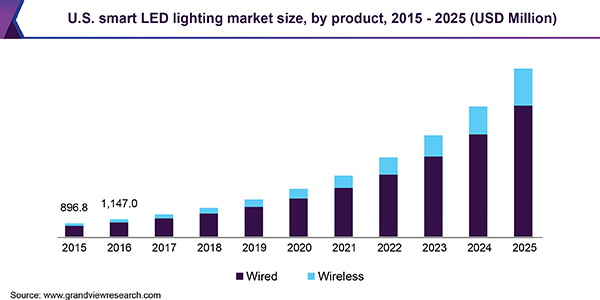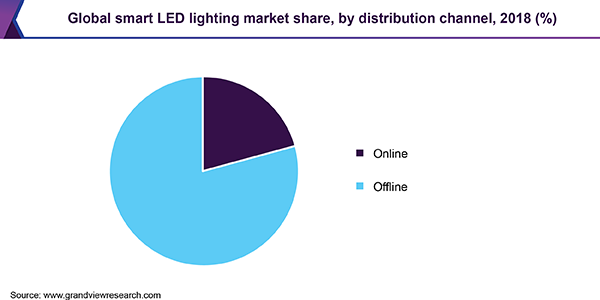- Home
- »
- Electronic & Electrical
- »
-
Smart LED Lighting Market Size & Share, Global Industry Report, 2025GVR Report cover
![Smart LED Lighting Market Size, Share & Trends Report]()
Smart LED Lighting Market Size, Share & Trends Analysis Report By Product (Wired, Wireless), By Technology (Hybrid, Dali, WiFi, Bluetooth, Zigbee), By Distribution Channel, And Segment Forecasts, 2019 - 2025
- Report ID: GVR-3-68038-354-6
- Number of Report Pages: 80
- Format: PDF, Horizon Databook
- Historical Range: 2015 - 2017
- Forecast Period: 2019 - 2025
- Industry: Consumer Goods
Report Overview
The global smart LED lighting market size was estimated at USD 7.32 billion in 2018. Rising awareness regarding the technologies such as wireless optical networking data transmission, light fidelity, and the Internet of Things (IoT) is expected to positively impact the market. Over the past few years, growing demand for energy efficient lighting systems has been promoting the adoption of advanced products including smart LED bulbs.

Smart lights are available in the range of 0.1 to 100 watts capacity. These products provide features including automatic on/off control, Bluetooth connectivity, embedded WiFi technology, and voice control options. The rising adoption of these products as a hassle-free solution to control home or organization lighting is projected to drive the market. Furthermore, rising consumer awareness regarding the importance of energy conservation is encouraging the adoption of smart LED lights.
Governments are adopting smart city lighting projects to save energy and money. As per a report by the U.S. Energy Information Administration, around 39% of total energy cost is incurred through lighting. It has been observed that smart LED lighting has the ability to reduce energy costs in office buildings and industrial installations by 90%. A large number of cities have started investing in this energy-saving solution as it is considered safe, environment friendly, and helpful for daily data monitoring.
In August 2018, the Chicago Department of Transportation announced the implementation of the Streetlight Modernizing Program with the aim to replace 270,000 conventional street lights with LED bulbs in the next four years. Since 2013, the governing body of Barcelona installed various smart LED lampposts across the city. These lights contain motion sensors that detect vehicles on the road and automatically go off when the roads are empty.
Product Insights
Wired smart LED lighting generated a revenue of USD 6.02 billion in 2018. These products are predominantly used in corporates, industries, and government organizations as a result of their low installation as well as the low maintenance costs as compared to their wireless counterparts. Furthermore, the reduced possibility of failure issues associated with these products is projected to bode well for the product demand in the near future.
The wireless product segment is expected to expand at a CAGR of 26.6% from 2019 to 2025. People can access the operations of smart lights remotely with the help of handsets. The majority of these products are connected through Bluetooth and WiFi. Growing consumer spending on trendy lifestyles is driving them to use wireless voice recognized smart electronics gadgets. Furthermore, product innovation and development in new technologies including Bluetooth is expected to open new avenues over the next few years.
Technology Insights
Hybrid technology-enabled lighting generated a revenue of USD 2.28 billion in 2018. These products have automated programmed smart features which adjust the intensity of light as per the requirement. It is installed in the majority of corporate buildings across developed markets of Europe. Furthermore, these products are considered very helpful for greenhouse farms as they allow farmers to provide higher light intensity for the crops, for longer periods, with adjustable heat that can be managed inside the greenhouse. In September 2017, PROMINENT installed hybrid smart LED lighting with Plessey Semiconductors to increase their greenhouse tomato production.
The zigbee segment is expected to register the fastest CAGR of 32.3% from 2019 to 2025. Smart lighting products with Zigbee technology can be integrated as a single portable unit that allows controlling fans, television sets, air conditioners, electronic doors, security cameras, computer systems, and other electronic devices with a wall outlet. Companies are introducing new products with Zigbee technology, which is projected to bode well for the segment growth in the near future. For instance, in June 2019, SAMSUNG launched Smart Bulb with Zigbee 3.0 technology compatible with Google Assistant, Amazon Alexa, and Samsung’s Bixby Voice Assistants.
Distribution Channel Insights
The offline distribution channel was the largest segment with a revenue of USD 5.80 billion in 2018. A majority of consumers prefer purchasing the products from offline electric stores so that they can assist with product installation and after-service support. Corporate companies, manufacturing industries, and government organizations prefer to directly tie-up with smart light manufacturers. This factor is anticipated to further propel the segment growth.

The online segment is projected to expand at the fastest CAGR of 30.1% from 2019 to 2025. The rising number of online stores with competitive pricing is propelling the growth. Online dealers provide easy installation, attracting more consumers. Some of the key online suppliers are Amazon, AliExpress, and Flipkart.
Regional Insights
Europe held the largest smart LED lighting market share of over 35% in 2018. Rising adoption of luxury home decoration coupled and consciousness regarding the aesthetic appeal of the products, especially in the key markets including Germany, the U.K., and France is expected to remain a favorable factor for the growth. Furthermore, rising spending on the deployment of smart lighting controls by various associations including Belgium-based Lighting Europe and the U.K.-based Lighting Industry Association (LIA) is further propelling growth in public and private arenas.
North America is estimated to expand at the fastest CAGR of 28.4% from 2019 to 2025. The operational cost of lighting in commercial buildings is comparatively high in U.S. and Canada. Moreover, the buyers operating in profit-oriented organizations adopt smart lighting to reduce their electricity expenses.
Key Companies & Market Share Insights
Some of the key players are Cree Inc.; Eaton Corporation; Koninklijke Philips NV; ABB Limited; Wipro Limited; SSK Group; TVILIGHT B.V.; Digital Lumens, Inc.; Acuity Brands Inc.; Bridgelux, Inc.; and OSRAM Licht AG. Companies are investing in product innovation and development as well as entering emerging economies to gain greater market share. For instance, in October 2018, China-based manufacturer YEELIGHT announced its entry into the Indian market with new product launches including a smart lamp, smart bulbs, and light strip. Additionally, in July 2018, Philips Lighting announced plans to start 20 experience centers in India to cater to the domestic product demand.
Smart LED Lighting Market Report Scope
Report Attribute
Details
Market size value in 2020
USD 11.29 billion
Revenue forecast in 2025
USD 34.17 billion
Growth Rate
CAGR of 24.6% from 2019 to 2025
Base year for estimation
2018
Historical data
2015 - 2017
Forecast period
2019 - 2025
Quantitative units
Revenue in USD million/billion and CAGR from 2019 to 2025
Report coverage
Revenue forecast, company ranking, competitive landscape, growth factors, and trends
Segments covered
Product, technology, distribution channel, region
Regional scope
North America; Europe; Asia Pacific; Central & South America; Middle East & Africa
Country scope
U.S.; U.K.; Germany; China; India; Brazil; South Africa
Key companies profiled
Cree Inc.; Eaton Corporation; Koninklijke Philips NV; ABB Limited; Wipro Limited; SSK Group; TVILIGHT B.V.; Digital Lumens, Inc.; Acuity Brands Inc.; Bridgelux, Inc.; OSRAM Licht AG
Customization scope
Free report customization (equivalent up to 8 analysts working days) with purchase. Addition or alteration to country, regional & segment scope.
Pricing and purchase options
Avail customized purchase options to meet your exact research needs. Explore purchase options
Segments Covered in the ReportThis report forecasts revenue growth at global, regional, and country levels and provides an analysis of the latest industry trends in each of the sub-segments from 2015 to 2025. For the purpose of this study, Grand View Research has segmented the global smart LED lighting market report on the basis of product, technology, distribution channel, and region:
-
Product Outlook (Revenue, USD Million, 2015 - 2025)
-
Wired
-
Wireless
-
-
Technology Outlook (Revenue, USD Million, 2015 - 2025)
-
Hybrid
-
Dali
-
WiFi
-
Bluetooth
-
Zigbee
-
-
Distribution Channel Outlook (Revenue, USD Million, 2015 - 2025)
-
Online
-
Offline
-
-
Regional Outlook (Revenue, USD Million, 2015 - 2025)
-
North America
- The U.S.
-
Europe
-
The U.K.
-
Germany
-
-
Asia Pacific
-
China
-
India
-
-
Central & South America
-
Brazil
-
-
Middle East & Africa
-
South Africa
-
-
Frequently Asked Questions About This Report
b. The global smart LED lighting market size was estimated at USD 9.08 billion in 2019 and is expected to reach USD 11.29 billion in 2020.
b. The global smart LED lighting market is expected to grow at a compound annual growth rate of 24.6% from 2019 to 2025 to reach USD 34.17 billion by 2025.
b. Europe dominated the smart LED lighting market with a share of 36.2% in 2019. This is attributable to rising adoption of luxury home decoration, coupled with consciousness regarding aesthetic appeal of the products, especially in the key markets including Germany, the U.K., and France
b. Some key players operating in the smart LED lighting market include Cree Inc.; Eaton Corporation; Koninklijke Philips NV; ABB Limited; Wipro Limited; SSK Group; TVILIGHT B.V.; Digital Lumens, Inc.; Acuity Brands Inc.; Bridgelux, Inc.; and OSRAM Licht AG.
b. Key factors that are driving the market growth include increasing awareness regarding the technologies such as wireless optical networking data transmission, light fidelity, and Internet of Things (IoT), coupled with growing demand for energy-efficient lighting systems.
Share this report with your colleague or friend.
![gvr icn]()
NEED A CUSTOM REPORT?
We can customize every report - free of charge - including purchasing stand-alone sections or country-level reports, as well as offer affordable discounts for start-ups & universities. Contact us now
![Certified Icon]()
We are GDPR and CCPA compliant! Your transaction & personal information is safe and secure. For more details, please read our privacy policy.
We are committed towards customer satisfaction, and quality service.
"The quality of research they have done for us has been excellent."





